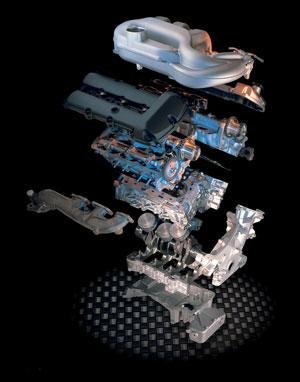
This case study focuses on the way in which Jaguar, one of the world’s most prestigious car manufacturers, has employed lean manufacturing processes. This underpins the success of the new Jaguar S-Type production line at its Castle Bromwich factory in Birmingham.
Jaguar is part of the Ford Group. Ford has for a number of years been improving its production methods, particularly by introducing manufacturing methods developed in Japanese industry. This includes lean manufacturing, a system pioneered at the Castle Bromwich factory. The system will be integrated into Ford’s Halewood factory prior to the production of the new Jaguar X400. Ford workers there will be developing a Jaguar motorcar, therefore the skills developed at Castle Bromwich need to be successful at Halewood.
Lean manufacturing is the process of eliminating waste in production in order to guarantee quality and maximise efficiency. Lean production involves the standardisation of work processes to cut out waste. The standard is the best identified method of operation at a particular moment in time and one that will be continuously monitored and improved by the individual operator.
The key to lean production is to identify which processes in the organisation of production add value to the production process. Processes which do not can then be reduced or eliminated so that labour and machinery can focus on added value activities. This does not mean that production line workers and machinery have to work harder – rather they need to be able to work ‘smarter’.
The change process
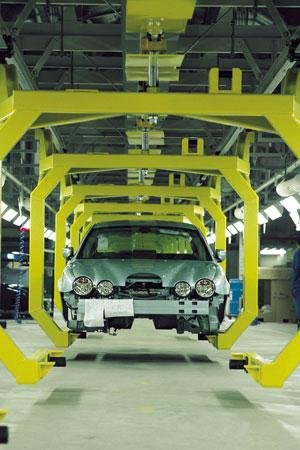
In order to create and implement the change process at Castle Bromwich, Jaguar managers and supervisors worked with a team of outside consultants, RWD Technology UK Ltd to create an ongoing climate of change. Jaguar already had an established culture of quality around which the international reputation of the company was built. However, it was necessary to develop new ways of working and perceptions about continuous quality improvement.
Firstly, it was necessary to transform patterns of working relationships. Previously the factory had been organised using a hierarchical approach with one supervisor and one group leader taking responsibility for up to 30 production line workers. In the new structure a team leader works with a small group of seven team members.
The old approach was characterised by a ‘tell and do’ approach with instructions being fed downwards in order to exercise control from above. Today this pattern of decision making has been inverted. Group members are expected to take responsibility for their own work and to use team leaders for support – i.e. in a helping role. Jaguar workers have enthusiastically adopted the new approach as it allows for greater involvement and responsibility for improving their work patterns. Increased productivity and quality is clearly visible as a consequence.
The first step in implementing change was to ask workers to operate in small teams with a group leader – an approach known as cellular working. The teams (cells) were introduced to a series of new approaches (tools) designed to enable them to work more effectively. Teams were trained in their work areas rather than classrooms so they could see how to apply the new tools in a work based context, and feel comfortable and involved.
Matching supply to demand
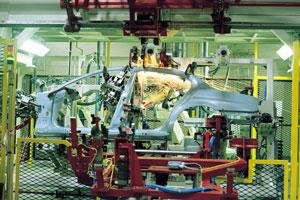
One of the most significant changes has been creating continuous flow system of production based on a ‘just-in-time’ approach. Previously, groups of employees had focused on set processes in the production of Jaguar cars using batches of components. The work area for a particular process would be cluttered with batches of components which resulted in a cramped working environment and less floor space.
The new approach is to cut down stocks of components in the workspace to the numbers required to keep production flowing smoothly. Teams press a signal button to call for fresh stocks when they are required. A quick response from a central store enables new parts to arrive at work stations ‘just-in-time’ for them to be used. This cuts out waste in a number of ways, for example:
- less floor space is required
- cells are able to work in an uncluttered work area
- walking (physically moving about between operations) is minimised
- fewer components are damaged from standing around in batches on the workspace floor.
One of the greatest measures of improved working systems at Jaguar has been to match the supply of new cars coming off the line at Castle Bromwich to the demand from Jaguar customers. Given the demand for Jaguar cars, production managers are able to calculate the volume of cars that need to come off the production line in any one week. Produce too few and you will not be able to meet demand; produce too many and you have the waste of rising inventory. The solution is to run the production line at the speed necessary to match demand patterns while retaining quality.
Visible management/visual factory
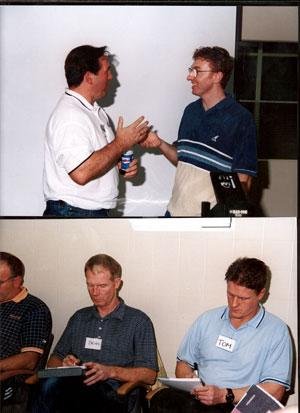
A system of ‘visible management’ has been introduced at Castle Bromwich to enable everyone involved in the process to understand how individual parts of the plant are performing so they can contribute to meeting performance requirements. An important part of this initiative is the use of Control Boards (i.e. visual screen) which everyone involved in the production process can read at a glance and check on the production performance of their production line. The Control Board reveals the daily production target for each production line and the performance of the line against this target.
At any one time anyone on the production line can see where they are in relation to target or where bottlenecks are occurring so that more help can be put into problem areas. Jaguar has adopted a Japanese word ‘gemba’ — which means to go see – to develop a new approach to production management and supervision. Managers are encouraged to gemba, i.e. to ‘go see’ – to understand, grasp, and solve problems when they occur rather than sit in remote offices.
The Control Board is a quick and visual tool for monitoring where problems occur on the production line. On the Jaguar production line, cars flow along a line with teams processing the work on the car in an ordered sequence. It is essential that each line worker completes their specialist tasks to the highest quality before the car moves to the next position on the line. If a worker is having a problem they pull a cord which alerts their team leader who will provide assistance. If the team leader, who is more knowledgeable and multi-skilled than other production line workers, is able to quickly solve the problem he pulls the cord a second time and the line continues to flow forward.
However, if the problem cannot be immediately solved the whole line will halt and then wait while the problem is solved. It is estimated that typically there will be 130 – 150 pulls of the cord per shift. The running total is recorded on Control boards indicating the performance of each line. This makes it possible for production managers and supervisors to identify problems more easily.
Another aspect of visual management is the use of open Information Centres in the work areas of the factory. These Information Centres are based on a ‘three minute management approach’. Information from the Centre can quickly aid employees – within three minutes – to understand work related visions and goals, issues and problems affecting particular sections of the work area.
The Information Centre is about communicating in a simple and direct way – using clear and graphic charts to highlight issues, events and progress. The charts and work plans which are pinned up in the Information Centre are signed by all of the managers, supervisors and team leaders involved in drawing them up to show a shared sense of responsibility and of understanding of work related issues.
Ownership of work
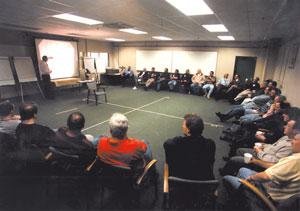
Under the new working arrangements at Jaguar, work teams have been encouraged to take responsibility for their own work. Work must be standardised so that everyone knows what they are accountable for and they can ensure quality standards. However, within each cell, team members will be responsible for writing their own work element sheets. In this way the team takes ownership for the processes and the amount of time involved in carrying out work.
Borrowing another idea from Japan – the ‘Yamazumi Board’ – the responsibility of each worker is outlined in a series of work elements. These work elements are shown in a vertical column on a Yamazumi board which is a flat white screen. The value added activities of each employee are shown in green and non-value added activities in red. The height of each vertical element represents the amount of time needed to carry out the element e.g. nine seconds. By examining the Yamazumi board it is possible to reallocate some work elements from some production workers to others in order to create greater fairness of work distribution.
Another purpose of work teams is to discuss their work in order to identify ways of reducing the time spent on non-value added related activities, i.e. to cut out waste – the purpose of lean production. Lean manufacturing requires ‘thinking’ at all levels within the organisation. The seven key opportunities for cutting down waste are:
- Removing over-production. Producing too much, too soon takes up storage space, and involves extra handling. Parts and products which have to wait to be used can be damaged, or become obsolescent, leading to wasteful scrap.
- Cutting out time spent waiting for parts to arrive.
- Reducing conveyance (i.e. moving things around the factory). Some conveyance is necessary, but it does not add value to the product.
- Eliminating over-processing – that is processing which goes beyond what the customer requires or processes which don’t add value to Jaguar’s product.
- Cutting inventory – i.e. the build up of stock. Only the minimum amount is required to get the job done. Having too large inventories causes interest charges and storage costs, uses up space and creates extra handling.
- Cutting down on wasteful movement by improving work plans and the management of parts and production facilities.
- Eliminating the need for repair. Not getting it right first time is wasteful.
Conclusion

Lean production is all about reducing waste. This involves working more effectively with TAKT time (the time available to produce each car). The teamwork approach is a recognition that the best way to achieve this is for all members of the workforce to be involved to achieve a quick response.
Lean production has enabled Jaguar to cut out waste in the production of the Jaguar S-type at Castle Bromwich. Ford is now seeking to spread the message about lean production by incorporating a total of 400 of its Halewood employees into working at Castle Bromwich. The successful implementation of lean production at Jaguar will form the benchmark for the systems introduction at Halewood.
